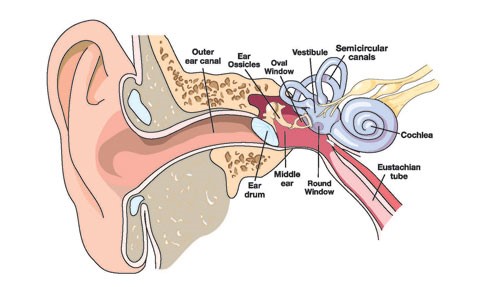Most important part of finding the right hearing aid is having a good hearing test. A good hearing test should consist of first looking in your ear for any kind of blockage, air and bone pure tone audiometry, word recognition, and a few other words test.
Your ear has three parts the outer ear, middle ear and inner ear.
When we hear t here is a vibration that sound makes and travels down your outer ear, vibrates the eardrum, transfers to the oval window — starts the fluid motion in the cochlea, then the sound is transferred to the auditory either nerve. So, its extremely important to test the pure tone and the bone conduction.
here is a vibration that sound makes and travels down your outer ear, vibrates the eardrum, transfers to the oval window — starts the fluid motion in the cochlea, then the sound is transferred to the auditory either nerve. So, its extremely important to test the pure tone and the bone conduction.
We look in your outer ear before the test, if we see a blockage we would make sure it was removed before doing the test. Either we will attempt to remove it or sent you to an ENT (Ear Nosie throat DR) to have it removed.
Air scores are performed with pure tone testing, this is done with ear muffs or probe tubes. I like probe tubes better because if you have a collapsible ear canal then sometimes the muffs can collapse your ear canal causing a hearing loss. Also, with the probe tubes I am getting a better test for setting your hearing aid. You are going to hear better the closer we can test to your eardrum. The hearing aid is sending sound closer to your eardrum like the probe tube does. With probe tubes for ear muffs we are testing to see the quiets sound you can hear at different frequents starting from your outer ear canal.
Bone conduction testing we are putting a bone oscillator on your mastoid bone bypassing your outer and inner ear. Your mastoid bone is right behind your ear. If your bone scores are better than your air scores you have a conductive hearing loss. A conductive hearing loss means there is something wrong in you outer or inner ear. We ruled out outer ear before we started the test so then that tells us it must be the inner ear. There are so many things it could be to something really miner to something that we would be really happy we could catch. Sometimes there is something that can be done to improve your hearing and you would not need hearing aids. If your bone scores are the same as your air scores, then you have a sensorineural hearing loss. Sensorineural hearing loss means that your hearing loss is from your cochlea on. This usually means there is nothing we can do for you except amplification like hearing aids.
Word recognitions sores are important to see what your understanding is after we put on the hearing aids. We give you a bunch of words “say the word boy” you would just say boy or whatever that last word is. We give you this test at you most comfortable listening level. This will tell us how you will do with your hearing aids. If your sore is 30% then we know with your hearing aids you will only understand 30% of what is being said and the other 60% of the time you will hear it just not understand it. I would be like the 60% of the time you would hear a foreign language.
The longer you go filling in the blanks of words the more you run the risk of losing the understanding of your language. Kind of like if you learned a foreign language in high school and did not speak it for 20 years. When someone 20 years latter spoke to you in that language you would not understand all the words. So, it is important to get hearing aids before you lose the understanding of your language.
After all the testing is done then your hearing care professional will discuss the results with you. Your test will be explained to you and recommendation will be made on your next steps. Depending on your test results and the reason you came in we might recommend, hearing aids, referral to your primary care physician or Ear Nose Throat DR, when your next follow up test should be, assistive devices and what your concerns are with the results.
